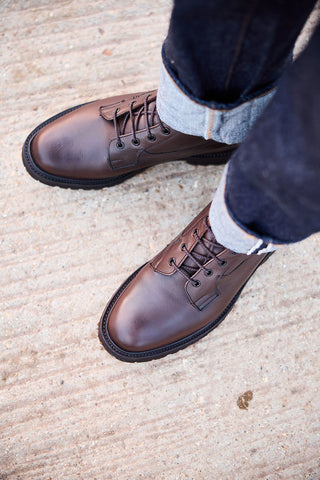
Our rugged natural Kudu leather is inspired by the exploits of David Livingstone and a generation of Victorian African explorer’s.
Kudu leather has been used for footwear in Africa for over two thousand years, due to its unbelievably hard-wearing qualities, softness and a subtle sheen which helps to illuminate the rich, pebbled texture of the hide

Our Kudu leather comes from the Greater Kudu, an animal that roams the woodlands of East & South Africa. Due to the habitat and its natural predators such as leopards, lions, African wild dogs, and hyenas, the Kudu will often graze sharp bushes that leave natural scars and scratches on the skin, making each pair totally unique.
Kudu leather is one of the most unique options as it features some scratches and scars – which immediately gives the leather its inimitable character to produce one-of-a-kind boots and shoes.
The hides used by Tricker’s are procured exclusively from Namibia and South Africa where numbers are thriving, and effective licensing regimes are operated to manage the population where they are a by-product from the local meat industry

The Kudu is considered to have persisted in greater numbers than many other species of large antelope, due to its secretiveness and its ability to survive in undisturbed pockets in otherwise cultivated areas.
In South Africa and Namibia, they are highly prized for their meat and are culled regularly for export. Each animal is culled under license by local authorities in order to control their numbers and to generate income which contributes to the local economies and helps to finance the conservation operations of the game reserves.
Even though Kudu leather is tough and strong it gracefully ages thanks to its malleable composition. With enough wear, Kudu leather develops a rich, rugged patina while you add your own battle scars next to those naturally formed in the African bush.
This means that the skin must be durable to cope with such intensity which is an excellent property for Tricker’s Country boots. The material is tough but surprisingly soft and supple. In most cases the leather tannery sands the hide to remove imperfections but there is always some that remain. These give Kudu Shoes their distinctive look.

HOW TO CARE FOR KUDU LEATHER
When treated correctly, Kudu leather is soft to the touch, kind to your feet with slipper-like comfort and is extremely stylish.
As with all Kudu leather, the Kudu Original provides a uniquely soft and supple, yet strong and durable leather
- Firstly, insert your shoetrees and brush your shoes to remove any dirt or dust.
- Apply a very small amount of cream all over the shoes. We recommend using our creams since they have been specially formulated for our different calf colours. Our creams will restore colour and shine. You can also use a slightly darker shade if you would prefer to create burnishing effects.
- Which leather colour would you like to shine? Pair it with the perfect cream and wax colour.
- Once your cream has rested and absorbed, brush your shoes to remove excess.
- You can then proceed to apply your matching colour wax; this will give your shoes are lovely shine finish. Dab your cotton chamois and rub the wax in circular motions through your shoes. Let the wax set for a few minutes and brush.

Bourton Country Shoe in Gaucho Kudu
The leather is made from farmed in the wild Antelope skins. These skins have all the hallmarks that you would expect with the scratches and marks adding to the beautiful appearance of footwear in this leather. Full-grain with a semi-aniline finish. During our shoeroom methods we also burnish which gives a lovely deep aniline appearance.
You can see our full range of Kudu leather footwear here.


